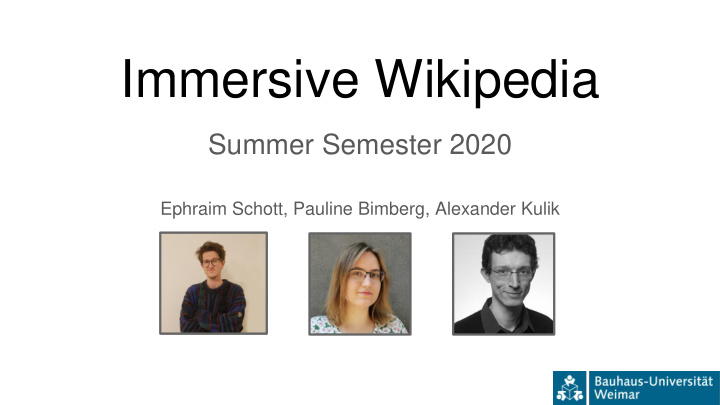



Immersive Wikipedia Summer Semester 2020 Ephraim Schott, Pauline Bimberg, Alexander Kulik
Background The Virtual Reality and Visualization Research Group is developing systems for collaborative 3D data exploration and analysis, e.g. in the fields of: Archaeology Cultural Heritage Design and Architecture https://www.uni-weimar.de/de/medien/professuren/medieninformatik/vr/research/multi-user-virtual-reality/
Motivation Online VR applications allow us to meet in virtual environments. Hey, let’s remotely explore the ‘Haus am Horn’. “ Haus am Horn ” by sailko Background Image: (CC BY-SA 3.0)
Users can explore the world together and get to know their environment. Why is there no window on that wall? “ Haus am Horn ” by sailko Background Image: (CC BY-SA 3.0)
Have a look at this scheme. It shows that there is a bathroom behind that wall. “ Haus am Horn ” by sailko To collaborate successfully, users want Background Image: (CC BY-SA 3.0) to retrieve and share different types of information.
We envision collaborative virtual environments, in which context-related information can be requested with natural language and smoothly embedded as well as directly exchanged and discussed with others. Bauhaus-Universität Weimar e. V. Courtesy of Freundeskreis der Background Image:
Apparently, the design was from Georg Muche. The walls seem flimsy for that time. Wasn’t it This is his isometry. badly isolated? Here is an original Bauhaus-Universität Weimar e. V. Look, there is an Torfoleum advertising using Courtesy of Freundeskreis der illustration of the wall this model house as an structure. They used example. Torfoleum as an Background Image: isolation layer.
Our goal in this project is to create a Apparently, the design was from Georg Muche. The walls seem flimsy networked 3D demonstrator, for that time. Wasn’t it This is his isometry. badly isolated? showcasing different interaction concepts and techniques for cooperative information gathering and exchange. Here is an original Bauhaus-Universität Weimar e. V. Look, there is an Torfoleum advertising using Courtesy of Freundeskreis der illustration of the wall this model house as an structure. They used example. Torfoleum as an Background Image: isolation layer.
Hierarchical 3D Context Menus Our development of a hierarchical 3D context menu for spatially anchored images may serve as a starting point. The presented information is assembled in real time on the basis of an object- related request. https://vimeo.com/401272667#t=166s
State of the Art Online VR applications like Mozilla Hubs support mutual exchange and the immediate integration of related (and unrelated) content form the web. However, the information cannot be semantically linked to features of the geometry. Effective interaction techniques for placing, requesting, showing, and the long-time management of such additional information are missing.
Project Structure Frameworks: Unity3D, mozilla hubs Programming languages: C#, JavaScript Organisation: Slack, git, moodle Assessment based on : ● Active project participation ● Intermediate presentations ● Development and prototyping of an interaction concept ● Documentation
Project Timeline Step 1: Requirement Analysis in Hubs ● How can we discuss virtual models in collaborative spaces? ● How can we embed additional information? ● Which features can we use? ● Which features do we miss? Requirement Analysis
Project Timeline Step 2: Development of Concepts/Storyboards Requirement Analysis Concept Development
Project Timeline Step 3: Development of Unity prototypes Requirement Analysis Concept Development Prototyping
Project Timeline Step 3: Integration into a networked application Requirement Analysis Concept Development Prototyping Integration
Participants Participants overall (max.): 4 Study Programme Max. Participants Study Regulation Credits Medieninformatik (BSc) 4 all 15 Computer Science for 4 all 15 Digital Media (MSc) Computer Science and 4 all 15 Media (MSc) Human-Computer 4 PV17 and lower 15 Interaction (MSc) PV19 12
Requirements Helpful Foundations: ● Programming skills (e.g. successful completion of the “Programming Languages” course) ● Successful completion of the VR course ● Capability of working independently and in teams ● Unity and networking experience Technical Requirements: - Fast internet connection (must-have for distributed work in virtual environments) - Access to a powerful computer with a graphics-card* * Can be provided/loaned in Weimar if necessary
Project Goals ● Fundamental implementation skills in Unity3D ● Development of novel interaction concepts and techniques for context-related information gathering in collaborative VR ● Implementation and evaluation of novel interaction techniques in online virtual environments ● Development of a multiplayer VR-demonstrator of all suggested interaction techniques
Recommend
More recommend